Pannekoeks, John Dys & His Wooden Shoe
Saturday, September 22, 2007
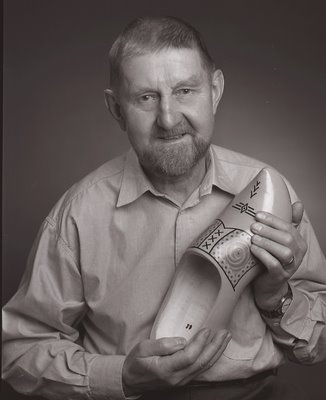 My Rebecca will eat sushi anywhere and anytime. The same applies to pancakes, specially the thin Dutch variety called pannekoeks. Rosemary and I take her and Lauren to the Dutch Wooden Shoe Cafe on Cambie. Rebecca and Lauren frequently go with their parents. Besides the delicious pannekoeks (Rebecca has a fondness for the cinammon and confectionery topping) she enjoys the warm bantering of owner John Dys who is in the kitchen but is always there to greet patrons. It was John Dys who founded the De Dutch Pannekoek franchise. By a convenient coincidence we in Argentina have our own version of Dutch pancakes. We like them big and we like them thin. We call them panqueques. We slather them with butter and dulce de leche. Sometimes we layer them with apples and burnt sugar, German style. Whenever Lauren and Rebecca sleep over I must (I need not be nagged on this) make panqueques for breakfast. When possible we have a jar of Argentine San Ignacio Dulce de Leche handy. But both Lauren and Rebecca opt for the confectionery sugar and cinnamon. It's hard to break that Dutch Wooden Shoe combination of John's.
Dickens, Phiz, My Father & Ronald Colman
Friday, September 21, 2007
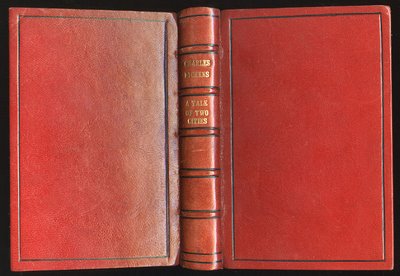 A tired Rosemary arrived a bit late yesterday. It was 6:30. I told her I didn't have time to cook because there was a good movie starting that minute. We each poured some milk on cereal (her unhealthy variety was Kellog's Frosted Flakes and mine was Kellog's Corn Pops) and sat down to watch the wonderful tear jerker Random Harvest (1942) with Ronald Colman and Grier Garson. This was the second time for me as I saw it in my youth with my father and mother in BA. But I wasn't old enough to appreciate the supporting acting of Susan Peters. She would have been a star had it not been for a hunting rifle accident that pierced her spine in 1945. She starved herself pourposely to death in 1952. The film cried to be in colour as various references are made by Coleman on Grier Garson's red hair. As I watched the film with Rosemary I was hit by a tremendous nostalgia for my father who sported a Ronald Colman moustache and had a voice that was almost as good. 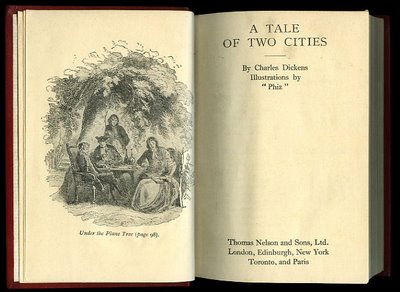 The only object that I inherited from my father and has some of his presence, is his copy of the King James Bible which has half his signature, the other half somehow was torn out. But I did inherit, too, a quarto Charles Dickens A Tale of Two Cities with illustrations by "Phiz". On the front page I can see my father's name and date 1939. 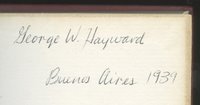 But I have never been fooled. I can spot my mother's Manila nun's school handwriting every time. I cannot remember how many times Hilary and I have watched Ronald Colman and listened to him say the last lines in, A Tale of Two Cities. "It is far, far better thing that I do, than I have ever done: it is a far better rest that I go than I have ever known." And both of us cry every time. I have never told Hilary that I remember my father reading those lines to me. He often read to me in bed. And I remember the line that precedes them in the book: ...and I hear him tell the child my story, with a tender and a faltering voice.In spite of all that I have never heard Colman read the complete sonnets of William Shakespeare (all 154 of them) from my two-cassette set. Once I listened to them in bed making believe it was my father. By the time Colman said, matter-a-factly, "Ten, (pause) For shame deny that thou bear'st love to any, Who for thy self art so unprovident." I fell asleep. 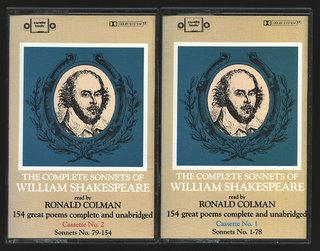
Sweet Juliet & A Burden To Bear
Thursday, September 20, 2007
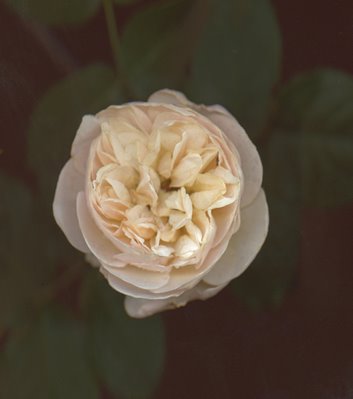 Waking up to a cool rainy day has a way of cooling off one's enthusiasm. I went into the garden and noticed that the English Rose, Rosa 'Sweet Juliet' was telling me, in few words, that she liked her new location in the garden. She had flowered well in the past inside a large pot by the pond. This year I moved her nearby, but into the ground. She has grown tall, and even as fall beckons she is in bloom with many buds promising even more to come. The flowers are not as large as they are in the summer but the sweet smell (similar to Rosa 'Maiden's Blush') is all there. Her fragrance dissipated my melancholy. As I looked at Sweet Juliet I thought into the future (a near one, perhaps?) when we will have to leave our house and move into a smaller one. Surely one of my daughters will want my roses. The hostas I will give to VanDusen as a collection. Rosemary will have to handle her perennials. Perhaps I will not be around for this sad occasion if my wish to make a quick exit via a clean and residue-less vaporization is realized. The fleeting presence of Sweet Juliet made me think of all those watch ads I have noticed in the New York Times of late. They advertise $3000 watches with all sorts of complications. My 20 year-old Filipino Timex keeps ticking (whirring?) on and I need a loupe to check the date but the time is accurate and visible. Even though there is something of the Argentine left in me I have no desire for a Rolex on my wrist. Sweet Juliet made me think of all the belongings we have amassed in our years on Athlone Street and the difficulty of having to move without them. The burden of possession is a burden that is hard to bear. I think of Brother Edwin Reggio C.S.C., who in his youth would have been sent from here to there at a moment's notice. It would all have been easy. A couple of pairs of shoes, a bible, some shirts, trousers and a shaving kit, would all have fit in a suitcase and he would have been ready to go. There was (for me it was only a passing fancy, even though I considered it) an attraction to that calling. I would have been reaping the benefits now had I answered it. The burden of possessions would certainly have been a lighter one. But then I think of Rebecca and (now) Lauren as I take in the fragrance of Sweet Juliet. I think of what Dag Hammarskjöld wrote in his autobiographical MarkingsWhat makes loneliness an anguish
Is not that I have no one to share my burden,
But this:
I have only my burden to bear.And I consider myself fortunate. More HammarskjöldAnd More
Ray Spaxman, Bill Yee & All Those Other Fine Men
Wednesday, September 19, 2007
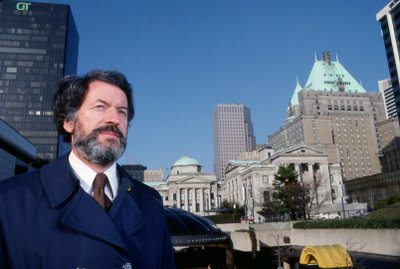
Between 1973 and 1989 Ray Spaxman, a practicing architect and planner in England before moving to Toronto (where he was a city planner) was Director of Planning for the City of Vancouver. He is credited with changing the direction of development of our city and bringing more public participation and community engagement into the planning process.
Starting in 1977 I started contributing photographs to Sean Rossiter's civic affairs column 12th & Cambie which appeared monthly in Malcolm Parry's Vancouver Magazine. On any given day that I might go to the old office on Hornby Street (a third of a block on the south east side and south of Nelson Street I remember one day seeing a most elegantly handsome man posing for photographer James La Bounty in Mac Parry's office. Behind the man, architect Arthur Erickson, were some buildings that soon would make way for his vision of Robson Square and the Law Courts. That day Erickson could have easily played either Raymond Chandler or Dashiell Hammett in a film. On other days I might find Max Wyman or Daniel Gutstein, who with Rossiter wrote on city development and housing. Or I might find a theatre actor or writer Ben Metcalf. It seemed that Vancouver Magazine's door was open to those who cared for our city and worked for making it what it has become today. And Parry never was that much of an elitist. For one memorable Christmas party in the 80s (by then the magazine had moved to Davie and Richards he had personally invited as many prostitutes as he could find on the street that evening. It was at that Christmas party where I saw my first ever punch bowl fountain and realized that the Playboy Magazine cartoons, of their Christmas issue, were based on fact.
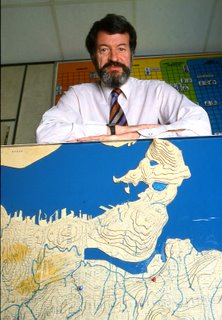
Some of us made jokes about Rossiter's obsession in writing about Spaxman. No matter the subject I was assigned to photograph the man. After a few sessions with Spaxman I understood Rossiter's enthusiasm. I am including here only four of the many more that I took of the man. The b+w was the last one and the gentle (but extremely tall) Spaxman posed by my side garden gate.
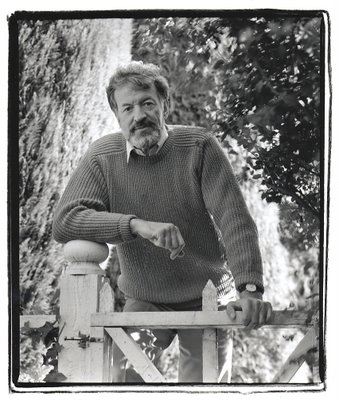
I thought he needed some texture so I lent him my electric blue knit sweater that Rosemary had given me for my birthday.
I remember one special day in the middle 80s when I had photographed Alderman Bill Yee in the morning. In the 80s aldermen were aldermen. We had hit it off and he invited me to attend to the opening of a new Chinese restaurant that evening. I did not know what the evening had in store for me. When I arrived, with my illustrator friend Ian Bateson, there was a large round table. There were a few more aldermen, besides Yee, and the city clerk. And there was not only Ray Spaxman but also Vancouver City Engineer Fritz Bower who instantly reminded me of Wernher von Braun.
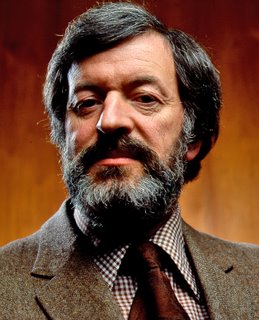
I had lived too many years in Latin American countries where we considered that all in politics were corrupt. Sitting at the table with these men (they were all men) who seemed to be philosopher kings had me in awe. The conversation was stimulating even though the 13th or 14 course was a most difficult to eat sea cucumber.
As I look back on those years I know I received a rare glimpse into the formation and planning of Vancouver. I saw Ray Spaxman a few weeks back. He was still the gentle man and he had the look of enthusiasm and love for the polis. A few months before I ran into Bill Yee at the Floata Restaurant in Chinatown. He is now an immigration judge. Vancouver has been blessed with these men but then there was May Brown and Darlene Marzari, and Shirley Chan, and Carole Taylor.....
After I had photographed Bill Yee I had returned to Vancouver Magazine. Equity Magazine was publishing out of the same location.
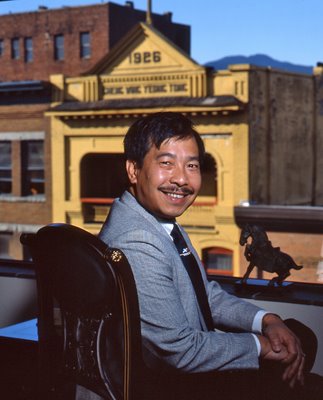
I went into editor Harvey Southam's office and told him, "Today I photographed a man who could be Vancouver's first ethnic mayor." Southam looked at me, and with a smile on his face he replied, "Not while we are around."
The Hose, The Fence & The Chain
Monday, September 17, 2007
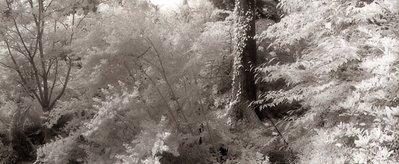
The bars of chapultepec are good for you. But only for you.
Are they painted red? No, no.
Are they painted blue? No, no.
Are they painted green? Yes, yes.
My poet/novelist/environmental friend Homero Aridjis in his novel ¿En quién piensas cuando haces el amor? (The title of this untranslated book would be "In whom do you think of when you make love?") writes of a not too distant future in which Mexico City's most famous park, Chapultepec Park, is mentioned by one of the protagonists as " el ex-Bosque de Chapultepec."
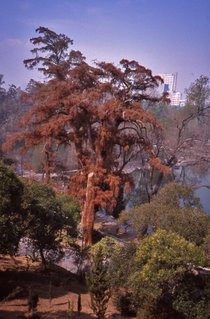
Rosemary and I had picnics in this park in the late 60s. We marvelled at the old ancient Taxodium mucronatum called ahuehuetes or simply cypresses by Mexicans. These trees were around during the conquest of Tenochtitlan by Cortés and his hordes. Now they are dying (note colour photograph) because of Mexico City's high pollution levels.There is one famous song that mentions the ornate wrought iron bars that surround sections of the park. It is called Las Rejas de Chapultepec.
Las rejas de chapultepec
son buenas son buenas
Nomas para usted
Las rejas de chapultepec
Las rejas de chapultepec
Son buenas son buenas
Nomas para usted
Estan pintadas de rojo? No no
Estan pintadas de azul? No no
Estan pintadas de verde? Si si
Roberto Kenny
Sometime in 1974 I posed by them with Alexandra and Hilary. I think Rosemary snapped the picture. At night the police would close all entry to the park with heavy chains. The chains have not prevented the Mexico City smog from all but killing those cypresses to Aridjis's dismay.
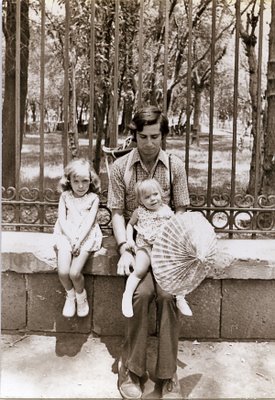
My first question when I arrived in Vancouver and drove through Stanley Park was, "When does it close?" The question was lost to most of the Canadians I asked. Most thought I was joking. They, being Canadian, had no concept of a chained public park. My wife Rosemary has helped me appreciate the varied splendor of our parks, specially the botanical ones of VanDusen, Nitobe Memorial Garden and the UBC Botanical Garden. We have gone on many a walk. One of our favourites is going through the huge collection of rhododendrons of the UBC Botanical Garden. Since this is a true botanical garden it does have gates and a fence, something I am familiar with. But there are places inside where you lose sight of the city and you feel you are surrounded by wilderness. I took the above Widelux (a 35mm swivel lens panoramic camera) picture with Kodak Infrared film. It was only when I was getting ready to print it that I noticed the hose.
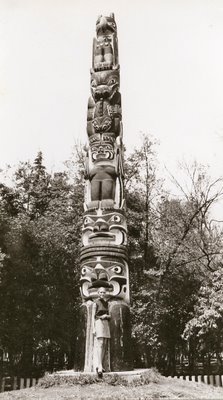
To me it is a fine Canadian touch. You don't tame a wilderness with metal chains. A hose will suffice. Strange as it may seem, my Brockville, Ontario-born wife saw her first totem pole in Chapultepec Park.
Note: To those why may have not noticed the maximum width of photographs in this blog cannot exceed five inches. But if you click on the image and wait, just a bit, the image will be larger. While keeping your mouse cursor on the image a button on the bottom appears with arrows, click on them and the image will enlarge further.
More Homero Aridjis
And Even More Homero Aridjis
The Great Gatsby, Tim Bray & The Mayan Long Count
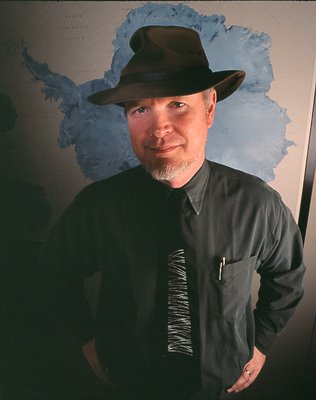
Saturday night Rebecca and I went to EDAM and enjoyed an intimate combination of avant-garde dance, contact improvisational dance and some modern ballet. We had (she did as I had miso) some sushi at Kishu Island Japanese Restaurant on Main and Broadway and then we came home. She was sleeping over as was her sister Lauren. When we arrived I picked up the New York Times that was at the door (it was 10:30) and I told Rebecca (not for the first time), "I am going to read tomorrow's newspaper today." I showed her the date which was yesterday's. She looked perplexed and said nothing.
There is a memorable scene in Jack Clayton's 1974 film The Great Gatsby where an immaculately dressed Jay Gatsby (Robert Redford) walks with someone else (I don't remember) down the side of a swimming pool in a late and sunny afternoon. One of them says to the other, "It was a great summer." When I saw this movie that statement affected me with a shock of emotion. It was sometime in 1975 and we had just arrived in Vancouver.
In my formative years in Buenos Aires I lived through four distinct seasons. Most memorable in my memory was spring. In September the city's jacarandás would all be that rare and brilliant blue. Once we moved to Mexico City the four seasons faded into two. One was a rainy season and the other the dry one. The mountains of the Mexico City valley were either green or brown to mark the seasonal difference. The zompantle (sometimes called a colorín) or Erythrina americana 'Miller', which we planted in our garden to enjoy its bright red flowers, would bloom sporadically all year, undecided and probably confused when spring would arrive.
It was finally in Vancouver, 32 years ago where the four seasons defined themselves to me in complete distinction, one from the other.
When people ask me, "How was your summer?" I usually reply simply with a, "Just fine." What I really want to say is far more complicated and it might upset them. I would say that as a freelancer and a person who does not go to school the seasons mean little to me as does the concept of the weekend. I work when there is work. And when I don't work I don't rest as I worry about getting work.
With the advent of Sunday shopping and 24 hour stores, for me the idea of a seven day week has completely eroded. My concept of time, 24 hours in a day, 7 days a week and 30 days in a month, has changed.
One person who seems to have adjusted is my friend Tim Bray. Don't ask me what he does. He says he works for Sun Microsystems. He was involved in the making of a computer language called XML. He travels the world and sometimes talks to the spooks in Langley, Virginia. Bray has a web log (he would never call it a blog) ongoing. Its content is usually over my head in complexity but every once in a while nice photographs appear and I understand some of the subjects. Bray's web log reflects the activity of a man who gets more text messaging than emails and whose sense of time, in relation to mine is even more radical. The idea of writing a diary with multiple entries during the day would be alien to a Victorian diarist. I might extend one of my blogs with an addendum (usually when I have made a mistake and someone fires off an indignant correction) but Bray has it all figured out. His blog is one long fragment of fragments. He calls each entry a fragment. His web log has no beginning that I can figure out. Could it be that Bray has figured the Mayan long count?
The Epson V700 & Charlie The Guardian Angel
Sunday, September 16, 2007
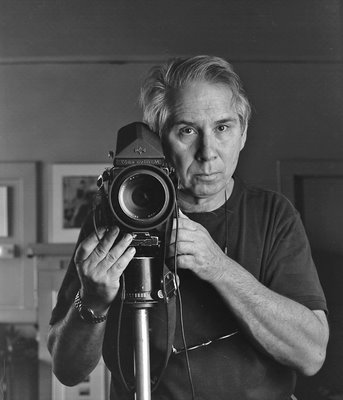 Four years ago my business as a photographer was floundering a tad. My wife Rosemary wanted me to scrap my film cameras and buy digital. I was thinking of the learning curve, the stiff investment in money I didn't have to buy the new equipment, and I was afraid of the unknown. My friend Paul suggested I buy a new computer and perhaps a scanner. Even that was a scary unknown. At the time I had a simple computer and I wrote articles for magazines and newspapers on Eudora, an email program. I was afraid of Word. Nick Rebalski at the Vancouver Sun thought it all very funny but he managed to edit my Eudora files. With Paul I went to a little shop on Bridgeport Road in Richmond and we ordered a computer by components. It was a stripped down computer designed to be used with a scanner. I bought a scanner, an Epson Perfection 1640 SU. One of my students from Focal Point came over and within a few minutes I was scanning film. It took a while for me to figure it out. It was a long time before I could remove dust specs from my scans. While the scanner was a good one, its soon evident limitations goaded me to find roundabout ways for solutions. These solutions became new techniques. I discovered that the combination of film/prints with the scanner (representing the digital world) gave me results that were unique. They were unique in that they could not be replicated in the darkroom or with Photoshop and a digital camera. They represented a third way. That $400 scanner liberated me and made me competitive. That $400 scanner made me adventurous. In recent months I have been taking one Polaroid (and not other film, just one shot) of my photographic subjects and gone home to scan it. In the past I would have rarely shot one exposure of film and retired the session. Now I am willing to do the same with film. My subject arrives at the studio. We converse and then we take that one shot. It is exhilarating! Perhaps because it is scary. But to remain competitive one has to be ahead of the times (in my retro film/scanner way). The 1640 with its 1200 dpi rating was more that sufficient to satisfy my editorial needs. But I needed a scanner with a more acute tolerance for film flatness. I have found it in my new Epson V700 that arrived a couple of days ago courtesy of a guardian angel by the name of Charlie.
|























